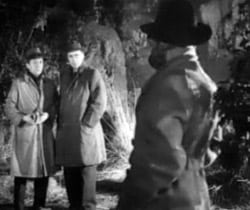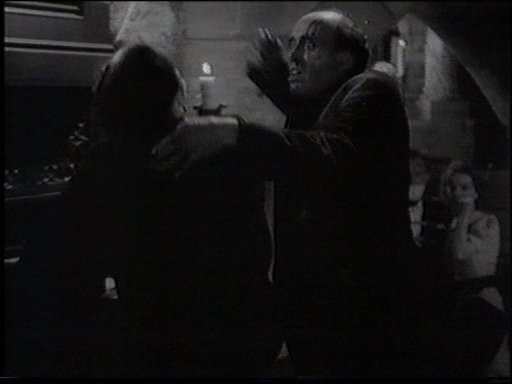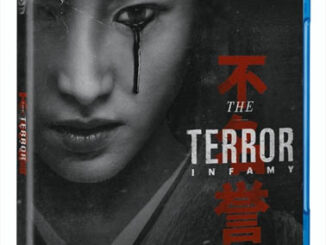The Terror (1938)
Directed by: Richard Bird
Written by: Edgar Wallace, William Freshman
Starring: Arthur Wontner, Bernard Lee, Linden Travers, Wilfrid Lawson
HCF REWIND 132: THE TERROR [UK, 1938]
AVAILABLE ON DVD: 10th June
RUNNING TIME: 68 min
REVIEWED BY: Dr Lenera, Official HCF Critic
The Terror, A mysterious criminal mastermind, learns that a large shipment of gold is to travel from Paris to New York via Southampton, and recruits the services of Soapy Marks and Joe Connor to hold up the bullion truck in a gas bomb attack. The robbery succeeds, but the Terror keeps the gold, and using the alias of Mad Mike O’Shea, tips off the police, causing Soapy and Joe to be imprisoned for ten years. After their release Soapy and Joe vow to have revenge and make their way to The Monks Hall Priory, a guest house which has an odd assortment of guests….
An old house with a notorious past. Guests, and indeed inhabitants, who may know more they’re letting on and one of whom may be a master criminal. Hidden gold. Men bent on revenge against the villain who betrayed them. An organ being played at night. A hooded monk. Hands reaching out from behind the curtain. Secret passageways. These may seem like the ingredients for two hoary old melodramas, let alone one hoary old melodrama, and it all probably seemed old-fashioned back at the time of its release in 1938, but that seems to have been the point. No, there’s nothing really original about The Terror, but it seems to be in part a bit of a send-up, with quite a few laughs, and having some fun with all the cliches, clichés which were as abundant in ‘B’ pictures of the time as, for example, masked killers killing teenagers have been since the early ‘80’s. The Terror certainly isn’t anywhere near the best film of its type that I’ve seen, but it’s good fun and a decent example of a ‘programmer’ or ‘quota quickie’ that, if it doesn’t really rise above its limitations, certainly does the best it can with its ingredients. The plot has its surprises, there’s a great cast, and it all oozes with that wonderful atmosphere that seems to be unique to black and white movies; if you like the classic Universal horrors, for instance, which I have written about elsewhere for this site, you should get some enjoyment out of The Terror.
After The Four Just Men, I was quite eager to receive the next of the films based on the work the once hugely popular thriller writer Edgar Wallace that are being released by the company Network, who have a really commendable dedication to restoring and releasing obscure gems [and maybe a few not-so-gems], of old British cinema. The Wallace original that The Terror derived from was actually a play, and you can tell this from watching the film, though it’s not really a problem. It was first filmed in 1928 under the same title, though this version seems to be lost. A sequel in 1934 has apparently played on US TV occasionally but not for several decades. It’s a shame that there seems to be little interest in this kind of movie from that period, because such films are often more fun than much of the crap around now! Another version was made for ITV in 1956, and then another, less faithful, version called The Sinister Monk in 1965 which was part of the lengthy krimi series of Wallace-based movies made in Germany.
The Terror opens in a good fashion with the titles coming out at you in a slanted manner, as terrifically over-the-top melodramatic music plays over them, really putting the viewer in the mood for what is to follow. Then follows a few minutes of some of the most economical storytelling I’ve encountered in ages, as a truck containing gold is robber using gas, the guy in charge of the robbery turns the other two over to the police before disappearing with the gold, then after ten years passes [this is charmingly signified by news footage of some of the important events that occurred], they get out and, after telling the police they don’t know where the gold nor know where Mad Mike O’ Shea are, set off for the Monk’s Hall Priory to wreck revenge. All this happens in an incredibly fast seven or eight minutes, and I reckon I must have missed exactly why they are going to the Monk’s Hall Priory. Maybe it was mentioned, maybe it wasn’t, but I like to review first-time films on first impressions, and not go back to see them, or bits of them, again, so all I will say is that certain details seem a bit vague on a first viewing!
The pace changes considerably when we switch to the boarding house where nearly all the rest of the film takes place. It becomes a great deal slower, though I wouldn’t say it’s boring. We get to know the often strange people that either live or lodge in this gloomy place. They include a Mrs Elvery, a psychic who knows a murder or murders will happen, but is no help whatsoever to the police when they do.
“For years I’ve had my suspicions”
[a policeman] “Of whom?”
“Of everyone”
Then there’s Hawkins the grumpy butler who complains that he gets so little sleep that a gun couldn’t wake him up, pretty young Mary who is kind of the ‘heroine’ of the piece when she becomes the one who starts to hear and see things like footsteps, an organ playing and a ghostly monk walking in the garden, and, my favourite character of all. Ferdy Fane. Played by none other than Bernard Lee, ‘M’ in the first ten James Bond films, this guy is permanently [and convincingly] plastered, prone to saying things like “I never sleep, it interferes with my drinking”, and, amazingly, the male romantic lead. Lee is brilliant, but then so too is the great Alastair Sim [the cinema’s best Scrooge] as one of the guys out for revenge who also shows up in this increasingly crowded boarding house. He switches from spine-tingling villain to friendly comedy vicar with consummate ease.
Elsewhere, some other characters make a great impression with often just one scene, such as a coroner who seems rather too happy that his latest ‘job’ is victim of a strangulation. Alfred Hitchcock would have liked some of the details in this film, like the conversation about a man who chopped his wife up into small bits. When the screams and the deaths start happening, the film isn’t really scary, and probably wasn’t even when it came out, but it’s not really trying to be. It’s trying more to make you shudder and chuckle almost at the same time. The best example of this is Mary wakes up in her bed to scream at something, which turns out to be her mother. Then the mother sees the ghostly monk outside and also screams. We cut to a dead body, and a shadow on the wall moves away from it as we here some sinister laughter. There is no way this is meant to be taken seriously, and yet the film is rife of atmosphere, especially when Marr Mackie’s music decides to stop trying to take over the film and we are left with virtual silence.
Of course it all ends with the heroine in deadly peril, and the climax is actually rather sloppily done, including a fight where none of the punches seem to be in synch with the sound effects. I doubt that this was intended. Still, you can’t really complain about too much of this sort of thing in a film like this, which is just intended as a lark. Unlike The Four Just Men, which I felt was quite ‘modern’ in some of its elements, The Terror is totally and utterly old-fashioned, but none the worst for that. I guess you may have to really old movies like me [I don’t automatically prefer them, I just like old and new equally and make no distinction] to totally ‘get’ it, but I think most people will get some entertainment out of it if they give it a go.










Be the first to comment